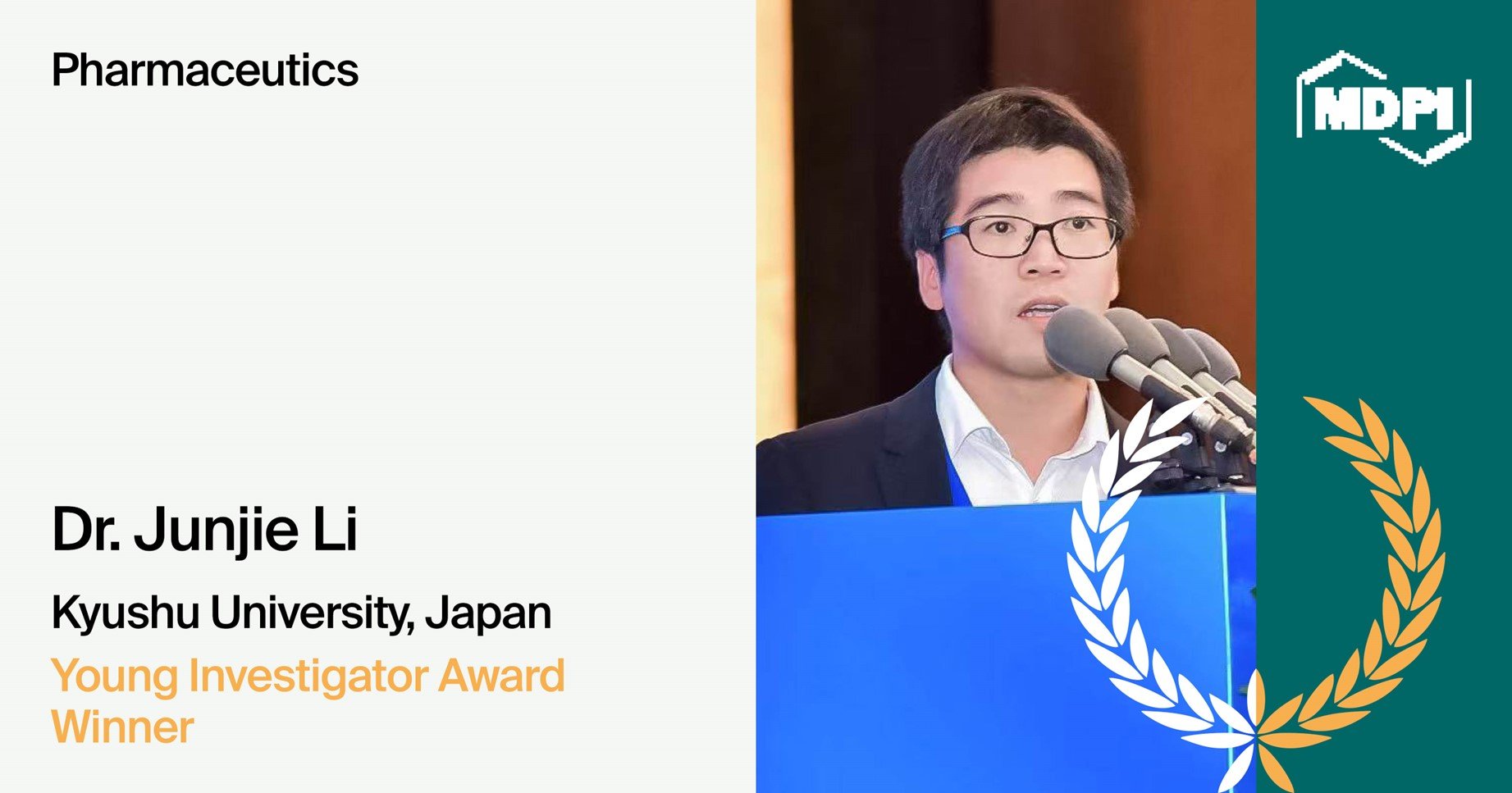
Journal Menu
► ▼ Journal Menu-
- Pharmaceutics Home
- Aims & Scope
- Editorial Board
- Reviewer Board
- Topical Advisory Panel
- Instructions for Authors
- Special Issues
- Topics
- Sections & Collections
- Article Processing Charge
- Indexing & Archiving
- Editor’s Choice Articles
- Most Cited & Viewed
- Journal Statistics
- Journal History
- Journal Awards
- Society Collaborations
- Conferences
- Editorial Office
Journal Browser
► ▼ Journal BrowserNeed Help?
Announcements
27 April 2025
Interview with Dr. Junjie Li—Pharmaceutics 2024 Young Investigator Award Winner

We announce Dr. Junjie Li as the winner of the Pharmaceutics 2025 Young Investigator Award. The Pharmaceutics Young Investigator Award was established in 2018 to acknowledge the achievements of young investigators in the field of pharmaceutics. All winners were chosen by the journal’s award committee.
Name: Dr. Junjie Li
Affiliation: University of Tokyo, Japan
Research interests: biomaterials; nanotechnology; drug delivery
We were honored to interview Dr. Junjie Li. Let us hear his opinions and hear about his experiences with scientific research and awards. The interview is summarized below:
1. Could you give a brief introduction of yourself to the readers? Can you introduce your current research direction and provide an update on your progress?
I am Junjie Li, an Associate Professor at Kyushu University, Japan, specializing in polymer-based pharmaceutics and bioactive materials. My research centers on the design and development of stimuli-responsive polymeric biomaterials for advanced biomedical applications, with a particular focus on drug delivery systems, biocompatible coatings, and tissue engineering strategies. Over the years, I have been especially dedicated to creating new nanoplatforms—such as polymersome-based nanoreactors—to tackle key challenges in targeted drug delivery and controlled therapeutic release. Since joining Kyushu University, I have broadened the scope of my work to include the design of macroscopic, surface-engineered polymer coatings that are both biocompatible and bioactive, aimed at enhancing the performance of medical devices. A central theme of my research is the exploration of biointerface interactions, which is critical for optimizing the functionality, safety, and clinical translation of these materials.
2. Which research topics do you think will be of particular interest to the research community in the coming years?
I believe that the convergence of smart, stimuli-responsive materials with cutting-edge fabrication techniques—such as 3D printing and AI-driven design—has the potential to revolutionize the field of biomedical engineering. Equally transformative is the development of bioactive materials capable of modulating the immune system or the microbiome, which opens promising avenues for the treatment of complex diseases such as cancer and autoimmune disorders. A particularly exciting frontier lies in merging polymer chemistry with the principles of structural biology and computational design to create foldable, functional macromolecules. These next-generation materials not only expand the existing toolkit for targeted drug delivery but also pave the way for entirely new therapeutic paradigms, such as synthetic biocatalysts and adaptive biomaterials that can evolve in real time in response to dynamic biological cues.
3. Could you share any particularly interesting or unexpected results you have discovered so far in your research?
One particularly intriguing finding from our work on polyion complex materials challenges a long-held paradigm in the design of stealth biomaterials. While probing mechanisms underlying immune evasion, we discovered that the stabilization of intermolecular ion-pair networks—rather than the conventional emphasis on maximizing steric repulsion—can significantly reduce protein adsorption and macrophage uptake. This “steric stabilization-independent stealth effect” runs counter to traditional approaches that rely heavily on flexible polymer brushes, such as PEG, to achieve stealth properties. What makes this discovery compelling is its potential to shift the design paradigm from entropy-driven strategies toward a more structurally holistic framework, opening new avenues for creating stealth and functional materials with enhanced biological performance.
4. Do you have any advice for aspiring young researchers looking to make a meaningful impact in their respective fields?
You don’t need a perfectly mapped-out life plan to thrive in science. Many researchers—myself included—find their way through exploration, uncertainty, and gradual self-discovery. It’s completely normal to feel unsure about where you’re headed or whether your work is meaningful. What matters most is staying curious and committed. Trust that curiosity-driven work holds value, even if its full impact isn’t immediately obvious. Surround yourself with mentors who see your potential and collaborators who challenge and inspire you. Sometimes, when your own confidence wavers, it helps to lean on others’ belief in you. Making a meaningful impact often takes time—it’s rooted in developing deep understanding and expertise. Don’t shy away from long, difficult projects; those are the ones that shape your skills and credibility.
Think of yourself as an explorer, not just a competitor. Focus on the journey of discovery, embrace the uncertainty and let that guide you forward.
5. As the winner of this award, would you like to take a moment to share your thoughts with our readers or express gratitude towards those who have played a significant role in your research accomplishments?
I am deeply honored and humbled to receive this award, and I would like to express my sincere gratitude to the many individuals who have shaped my journey as a researcher.
Prof. Kazunori Kataoka, a pioneer in polymer-based drug delivery systems—his visionary mentorship has profoundly shaped the direction and ambition of my research. I still vividly remember his words during a group meeting: “When you get results that you don't want at all, think differently—that's exactly your opportunity.” That mindset has stayed with me and continues to guide how I approach challenges in science.
Prof. Masaru Tanaka, an innovator in biocompatible materials—his deep insight into biointerfaces continue to expand my perspective.
Prof. Zhishen Ge, my Ph.D. advisor—his unwavering support and rigorous training laid the foundation for my scientific career.
This award reaffirms the value of pushing the boundaries in pharmaceutics and biomaterials. I hope it can serve as encouragement to young scientists to approach unsolved problems with boldness, curiosity, and persistence. Together, let us continue to redefine what’s possible in drug delivery and beyond.




